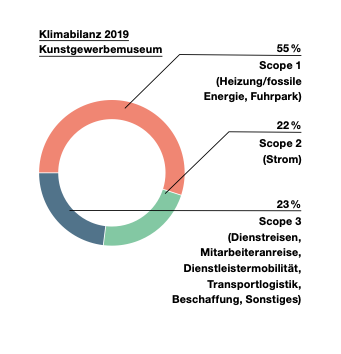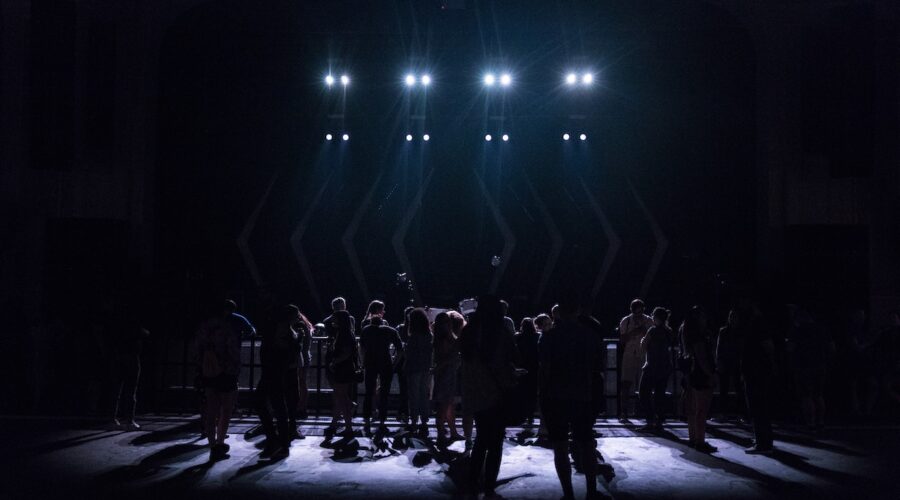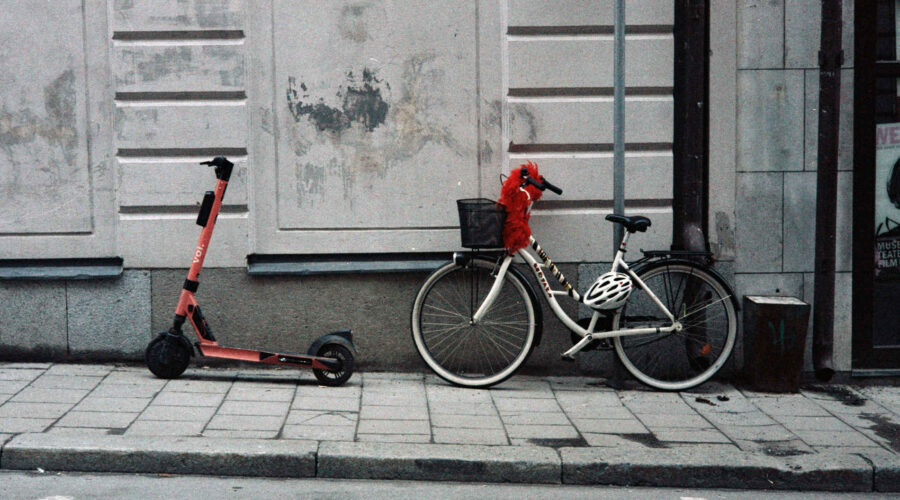Not only because of the coronavirus crisis, but also out of inner conviction, the desire for greater climate awareness and ecological Sustainability in cultural institutions.
New initiatives for the industry such as theSustainability Action Network for Culture and Media and pilot projects with various institutions help to obtain initial measurements of the ecological impact. Even though the need for climate-conscious work has long been recognised among cultural professionals, there is a lack of concrete knowledge (and often also a lack of time) for the first steps towards implementation in one's own organisation.
This article provides an overview of the ecologically relevant fields in cultural institutions and concrete tips on what can be improved.
Contents:
Why are cultural institutions concerned with sustainability?
The ever-increasing environmental impact caused by humans and, as a result, the progression of climate change are the central problems of this century. The younger generation in particular is currently calling on politicians and businesses to swiftly initiate the transition to a sustainable economy in harmony with nature. Culture can be seen as a social entity that has always dealt artistically with the pressing issues of our time and values. It can and must therefore address how people live and survive together. Culture is exciting outside of the ivory tower when it engages in sensual and creative reflection on contemporary issues and perhaps even finds answers.
In this function, cultural venues are also multipliers, as they bring together interested people from different backgrounds who are looking for inspiration. In addition to the content level, which creatively processes sustainability and climate justice, the so-called operational ecology level also plays a role. With their buildings as public visitor venues, which are usually maintained with funding, cultural venues are quasi objects of realisation where employees and visitors can experience climate-friendly restructuring. And the pressure will increase to the extent that laws require public bodies at municipal and state level to implement sustainability strategies in their areas of influence.

Where does ecological sustainability play a role in cultural institutions such as theatres, opera houses or museums?
a) The cultural institution itself
A number of dimensions play a role in environmental sustainability, including water use and pollution, biodiversity, land change, nitrogen and phosphorus input into the biosphere and others. Due to their field of activity in the non-manufacturing sector, cultural organisations themselves usually have a major impact through the emission of greenhouse gases into the atmosphere. These are mainly caused by the operation of buildings and events. Greenhouse gas emissions are a measure of climate impact that can be broken down to individual institutions and are now easy to measure. The international standard of the Greenhouse Gas Protocol helps to quantify how and to what extent greenhouse gases emitted have an impact on the environment in the form of CO2 emissions.

Museum of Decorative Arts in the baroque palace, source: Kulturstiftung des Bundes
Whether it's a theatre, museum or opera house, it's worth taking a look at the organisation, including the buildings (including warehouses) and the people who work there. In this mapping framework, CO2 sources are particularly important:
- Energy for heating and cooling, keyword energy efficiency
- the company's own fleet of vehicles (cars, vans, lorries) for transport
- Electricity consumption in the entire building for technology, lighting, etc.
- Employee mobility, i.e. business trips and travelling to work
- Arrival of the visitors
To understand the relevance of each area, we recommend calculating a carbon footprint that records the total emissions. In our Blog post "3 steps to a carbon footprint in companies" we have explained how to create these. Based on the empirical results, strategic short, medium and long-term reduction targets and measures can then be developed for the future. The publicly initiatedPilot project with 19 German cultural institutions did this for the first time in the cultural sector in 2021 and recognised the segments described above as important. The results varied greatly between the participating institutions.

b) The productions of the cultural institution
Climate-related aspects also play a role in the core business of cultural organisations, i.e. the performances, exhibitions, installations and workshops. As "core business", these are decisive for sustainability in the cultural institution. In addition to the above-mentioned aspects of electricity and technology, the materials used, for example for stage sets, costumes or exhibition design, also play a role. The analysis looks at building materials such as wood, metal, glass and much more, as well as aspects such as clothing and props. The list can be continued depending on the specific event.
Here, too, CO2 emissions can be quantified depending on the type and quantity of material, with transport and disposal being added to the calculation. For example, stage sets that consist of CO2-heavy elements such as painted foam panels but are stored and reused after use have a lower impact on the CO2 result than if these materials end up in the rubbish. The same applies to costume designs. These are often still tailored in-house at the theatre or opera, thereby at least partially avoiding the large complex of social working conditions in clothing production. However, the factor of fabric production with its implied environmental problems due to cultivation and dyeing processes in the countries of production also affects these cultural centres.
c) Content: Climate as context or content
A third ecological starting point for sustainability in the cultural institution is not measurable and rather 'soft', but nevertheless important in terms of significance. In the aforementioned function of culture as a 'processor' of social issues, perhaps even as a catalyst for change, a cultural institution can have an effect on its audience via the content level and stimulate reflection in each individual. Understanding ecological issues as part of creative dialogue is nothing new - art and culture have been doing this for a long time.
The urgency in this decade alone is far greater if Germany is to become compatible with the 1.5 degree target and reduce greenhouse gases by 65% by 2030 (compared to 1990). It is entirely up to the creative artists to decide how prominently or subtly they address climate issues in plays and exhibitions.
Making extensive use of the scope for this would be a good goal for cultural institutions that want to position themselves more ecologically.
Methods and best practice for sustainability in your mailbox

13 concrete measures for more sustainability in cultural institutions
Based on these considerations, what practical measures can be taken?
1. increase the energy efficiency of buildings: Insulation and technology
Poorly insulated or uninsulated roofs and walls and old windows mean that a lot of energy for heating and cooling is lost to the outside. Refurbishment measures in this context are often costly and involve high investments. Despite these hurdles, these are important building blocks for economical energy utilisation. Outdated spotlights and other technology also often consume much more than appliances that meet modern standards.
2. install renewable energies for heat generation: Solar systems and heat pumps instead of heating oil and gas
Converting or supplementing heat generation directly in the buildings - if no district heating is used - to renewable energies is a major gain in terms of climate impact. However, short-term implementation may not be easy for cultural institutions. A lack of financial resources and monument protection requirements can be a major hurdle.
3. purchase certified green electricity
Choosing an electricity tariff that is not based on coal or gas combustion, but on wind, solar, hydropower or biomass, on the other hand, is a measure that can be implemented quickly and has a major impact on the CO2 result.
4. 'Smart' consumption control: Automated switching on and off of electricity and heating
Automatically controlled energy supply e.g. with timers or programmable thermostats for radiators helps to minimise overall consumption in buildings. Raising employees' awareness of electricity use and the check in all areas of the building also contribute to the reduction target.
5. seek expertise: Energy consultants can help
The decision to install a solar energy system is best discussed in advance with experts from the energy advice centre. They can also help with all questions regarding improved energy efficiency and reduction potential and are, for example via the consumer centres approachable.
6. update the vehicle fleet: Low-emission hybrids or e-vehicles, e-bikes for short journeys
Electric bicycles are a much more environmentally friendly way of travelling short distances in urban areas than a car. At the same time, you are doing something good for your health. For longer distances and transport, e-cars or hybrids (especially in suburban areas) are an option for reducing greenhouse gases in the vehicle fleet. About Public funding programmes these purchases can also be subsidised.
7. make employees' journeys to work environmentally friendly: Incentivise cycling or public transport
Employees' journeys to work also count as employer emissions in a carbon footprint, so improvements are also worthwhile here. Ideally, attractive incentives should be discussed with the team and ideas collected together. Possibilities include free annual bicycle inspections, protected bicycle parking spaces or subsidised job tickets for public transport. Flexible working hours can also encourage employees to do without their car more often.
8. control visitor journeys: reduce parking spaces, instead enter into public transport cooperation
Visitor behaviour also plays an important role in the environmental sustainability of cultural institutions. In a city with good public transport connections, less car parking space can be a way to have a positive impact on the climate-friendly journey of visitors. This step should be well argued and communicated to the outside world in order to create understanding. Combined event tickets with free use of public transport have has already proved its worth in the cities. Even in more rural areas, clever public transport co-operation can make economic sense in addition to the ecological dimension. For example, closer bus intervals to the event venue and appropriate advertising can make attendance more attractive.
9. examine artistic production: Reducing the use of resources and waste
Calculating buildings for artistic events of all kinds as efficiently as possible during the planning phase saves money and avoids unnecessary waste. Ecologically problematic materials, such as paints that emit toxic vapours, are best replaced completely. Switching to environmentally friendly variants made from renewable raw materials, such as Cardboard for propsThis requires an innovative spirit, motivation and user testing. At the same time, this reorientation can be seen as a source of creative processes.
10. increase the reuse rate: Storage, lending and second hand mean fewer new purchases
Not everything has to be built from scratch for every opera or theatre production. Storing larger components in order to reuse them for the next production has recently gone somewhat out of fashion. The Federal Association for Costume and Scenic Design supports the new ecological focus of its industry and provides Helpful overviews for materials and costumesthat are applicable in the cultural sector.
In the costume sector in particular, the tried-and-tested principle of borrowing from a collection still applies. The growing range of second-hand shops or online clothes swap rings can also minimise new purchases.
11. acquire your own knowledge: Further training courses such as Transformation Manager Sustainable Culture
Expertise on ecology and sustainability is often still rare in cultural institutions, even if the motivation is often high. Training courses on Transformation Manager Sustainable Culture can transfer knowledge to the entire sector. In this way, holistic change processes can be initiated that are orientated towards the needs of the respective institution.
12. forming networks: Sharing experience and knowledge with other institutions
Whether the first steps towards more ecological sustainability in your own cultural institution have already been taken or are still to come - the exchange with industry colleagues is a tool that should not be underestimated. New ideas, best practices and also mistakes that have been made help everyone in a network to improve and motivate them to continue. There is a nationwide association for the industry in the Sustainability Action Network for Culture and Media.
13. call on the political level: Actively demand support programmes for ecological restructuring
From an industry network, it is also easier to demand more support for ecological measures from local and state politicians. And it is important to address ideas for optimal support to these authorities. After all, this is where the financial support programmes are set up that make environmentally friendly purchases in the cultural sector possible in the first place.

As most cultural centres are publicly funded, there is little room for manoeuvre and funding for substantial energy improvements to the buildings. One solution could be to organise the Sustainability strategy of the municipality or state. On this basis, it is then possible to enter into negotiations with the public authorities.
Support programmes and Political support for industry efforts already exists for museums. The Federal Cultural Foundation is also expanding its range of workshops for greater sustainability.
The cultural authorities themselves also initiate projects that aim to develop sustainability and ecological awareness in culture in the long term. For example, at the European Centre Hellerau, where values is planning to launch aProject on education for sustainable development (ESD) in art and culturethrough seminars and workshops.
To provide further assistance, we have compiled a collection of aids, positive examples and guidelines in our sustainability blog: Sustainability in art and a sustainable cultural sector.
Conclusion
The cultural sector can also play a part in society's efforts to achieve the Paris climate targets. Cultural event organisers should assess the ecological impact of their buildings, production processes and content and explore ways of minimising this impact. If the optimisation measures subsequently developed are communicated transparently to the outside world, the aforementioned multiplier role of culture for the topics of ecology and climate protection can be fulfilled in the best sense.

We work with companies on sustainability.
Strategy, controlling and corporate culture for sustainability.
For complex topics such as this, we provide advice, act as a sparring partner or provide impetus. If you would like to find out more about the topic or even tackle it yourself, please write to us:





[...] for sustainability in cultural institutions: This follow-up blog post from us provides an overview of what ecologically relevant fields of action in [...]
[...] Ecological sustainability in cultural institutions: Tips for action for theatres, operas and a... [...]
[...] Ecological sustainability in cultural institutions: Tips for action for theatres, operas and a... [...]